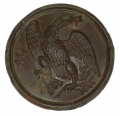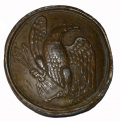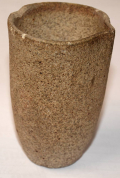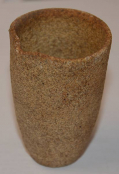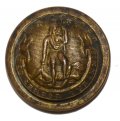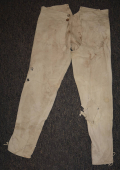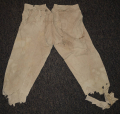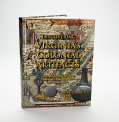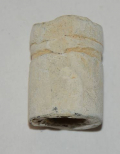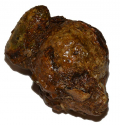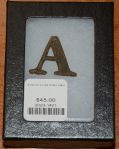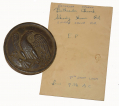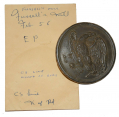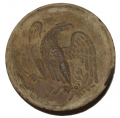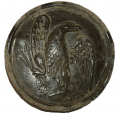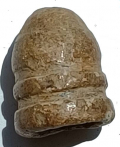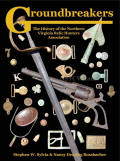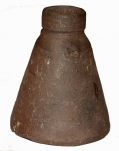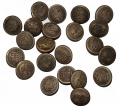site search
online catalog
Relics
Showing 201 to 250 out of 353
RUSSIAN FORT ROSS (CALIFORNIA) DISPLAY
Presented in a 9” x 6” wood display case is a round ball and a Russian-Siberian coin with labels. The .54 caliber lead rifle ball was recovered at the site of Fort Ross. This was a Russian fur… (236-794). Learn More »
SMITH MARKED ROUND EAGLE CARTRIDGE BOX SHOULDER BELT PLATE FROM MYERS HILL, SPOTSYLVANIA, EX-KERKSIS
This regulation belt plate for the cartridge box sling came from the collection of Syd Kerksis, well-known and respected early collector and author, and still has his annotated envelope indicating he… (490-5858). Learn More »
RELIC PATTERN 1826 EAGLE BREAST PLATE FOR MODEL 1840 NCO BALDRIC RECOVERED AT STONES RIVER
This Pattern 1826 eagle breast plate is meant for use on the baldric of the Model 1840 NCO sword. The face of the plate is in very nice condition showing only minor wear from age and use. The right… (490-5759). Learn More »
U.S. M1839 CARTRIDGE BOX PLATE RECOVERED BY SYD KERKSIS IN JANUARY 1958 IN THE LINES OF THE 4th CORPS AT PICKETT’S MILL: ATLANTA CAMPAIGN
This plate comes with its original collection envelope with notations on its provenance by Syd Kerksis, noted early collector and author. Pickett’s Mill was fought on May 27, 1864, in the Atlanta… (490-5779). Learn More »
CARTRIDGE BOX PLATE FROM TUNNEL HILL, GA, EX-SYD KERKSIS
This regulation US cartridge box plate was recovered on the battlefield of “Tunnel Hill, Ga,” by Syd Kerksis, one of the legendary early relic hunters and collectors, author of books on military… (490-5771). Learn More »
DUG PATTERN 1855 BAYONET FROM FREDERICKSBURG
Bayonet has full length blade and socket with mortise. Locking ring is frozen. No markings are visible. Surfaces are covered in a heavy rust with remains of black paint. It appears that once the… (2022-1319). Learn More »
MODEL 1855/61 GUN TOOL ONCE OWNED BY J. HOWARD WERT
Recovered at Gettysburg, this is a complete Model 1855/61 gun tool. It is heavily rusted and the screwdriver tip is rusted tight. At the time of the Gettysburg campaign, twenty-two year-old John… (224-798). Learn More »
MODEL 1855/61 GUN TOOL ONCE OWNED BY J. HOWARD WERT
Recovered at Gettysburg, this is a complete Model 1855/61 gun tool. It is heavily rusted and the screwdriver tip is rusted tight. At the time of the Gettysburg campaign, twenty-two year-old John… (224-797). Learn More »
MID 19th CENTURY CRUCIBLE ONCE OWNED BY J. HOWARD WERT
One of many articles amassed by Wert after the Battle of Gettysburg. A crucible is also a container in which metals are melted, usually for temperatures above 500 °C. Crucibles are made of graphite… (224-794). Learn More »
MID 19th CENTURY CRUCIBLE ONCE OWNED BY J. HOWARD WERT
One of many articles amassed by Wert after the Battle of Gettysburg. A crucible is also a container in which metals are melted, usually for temperatures above 500 °C. Crucibles are made of graphite… (224-793). Learn More »
SCARCE CIVIL WAR ISSUE SHOE ALTERED TO CAMP/BARRACKS SHOE
The army did not issue “post,” “barracks,” or “camp” shoes until the 1880s. Before that it was up to soldiers to privately purchase or improvise footwear that might prove more comfortable… (1052-426). Learn More »
U.S. ARMY MODEL 1892 CURB BIT ONCE OWNED BY J. HOWARD WERT
This piece of US horse equipment is an original U.S. Army curb bit of the 1892 First Pattern, (a.k.a. the Whipple Bit) and was once owned by Gettysburg native J. Howard Wert. In strong condition, this… (224-790). Learn More »
U.S. MODEL 1874 CAVALRY CURB BIT ONCE OWNED BY J. HOWARD WERT
This piece of original US horse equipment is an original U.S. cavalry curb bit of the 1874 pattern. In strong condition, this iron bridle bit has a hard pockmarked surface with moderated rust pitting.… (224-788). Learn More »
POST-WAR VIRGINIA STAFF OFFICER’S BUTTON BY HORSTMANN
This three-piece coat size Virginia button has substantial gilt left on the face and good detailing of the figures of the Virginia state seal and the motto on a ribbon on a lined background with an… (1000-2250). Learn More »
$115.00
Originally $145.00
SCARCE INDIAN WAR US ARMY 1872 PATTERN SHOE: FORT PEMBINA, NORTH DAKOTA, ESTABLISHED 1870
New pattern shoes and boots were introduced in the U.S. Army in 1872 and in use until the 1880s. These shoes improved upon Civil War issue patterns mainly by using brass screws in the soles, rather… (1052-303). Learn More »
SCARCE INDIAN WAR US ARMY 1872 PATTERN SHOE WITH FIELD REPAIR
New pattern shoes and boots were introduced in the U.S. Army in 1872 and in use until the 1880s. These shoes improved upon Civil War issue patterns mainly by using brass screws in the soles, rather… (1052-576). Learn More »
EXCAVATED MODEL 1855 PISTOL CARBINE PART
This unusual weapon consisted of a large single shot pistol that had a detachable shoulder stock which theoretically transformed it into a carbine. Here are two excavated brass parts from the pistol… (1000-1147). Learn More »
$260.00
Originally $325.00
VERY RARE CIVIL WAR U.S. ARMY ISSUE DRAWERS
Civil War army-issue undergarments are extremely rare. They were made and issued in huge numbers, but were characteristically cheaply made, often disliked, and hardly worth preservation as a cherished… (1052-255). Learn More »
VERY RARE CIVIL WAR U.S. ARMY ISSUE DRAWERS
This is a very rare set of Civil War army drawers, issued, worn and then discarded at a small frontier army fort after the war. These were made and issued in huge numbers, but were characteristically… (1052-256). Learn More »
$2,500.00
ON HOLD
“FORTY MILES A DAY ON BEANS AND HAY IN THE REGULAR ARMY-O” SCARCE INDIAN WAR US ARMY 1872 PATTERN SHOE FROM FORT PEMBINA, N.D.
New pattern shoes and boots were introduced in the U.S. Army in 1872 and in use until the 1880s. These shoes were similar to Civil War issue patterns, with square toe, rough-side out black leather… (1052-292). Learn More »
EARLY BARRACKS OR CAMP SHOE BY JOHN MUNDELL OF PHILADELPHIA
This is a usual soldier’s shoe from Fort Pembina, ND, a small U.S. army post from 1870 to 1895, and is typical army construction using rough-side out black leather and is clearly stamped “J.… (1052-388). Learn More »
SCARCE INDIAN WAR US ARMY 1872/76 PATTERN CAVALRY BOOT FROM FORT PEMBINA, N.D.
This scarce Indian War U.S. cavalry boot actually comes from Fort Pembina, a small U.S. Army frontier fort in North Dakota in operation from 1870 to 1895. The army introduced new shoe and boot… (1052-304). Learn More »
DUG 19TH CENTURY BRASS PROTRACTOR FOUND AT GETTYSBURG BY THE LATE RON MILLER
This small brass protractor meas. approx. 3.50 x 1.75 inches. The arc still shows faint measured graduations. Bottom center has a partial Philadelphia maker’s mark. Item was dug by the late Ron… (286-1212). Learn More »
EXCAVATED MODEL 1855 PISTOL CARBINE PARTS
This unusual weapon consisted of a large single shot pistol that had a detachable shoulder stock which theoretically transformed it into a carbine. Here are two excavated brass parts from the pistol… (1000-1146). Learn More »
$315.00
Originally $395.00
FIRST EDITION REFERENCE BOOK ON VIRGINIA COLONIAL RELICS FROM THE LIBRARY OF THE LATE DEAN S. THOMAS
The title of this volume is “DISCOVERING VIRGINIA’S COLONIAL ARTIFACTS. A COMPREHENSIVE GUIDE TO RECOVERY, IDENTIFICATION AND PRESERVATION” by Bill Dancy and published by Greybird Publishers of… (236-444). Learn More »
RELIC FRIZZEN RECOVERED FROM THE 1793 BATTLEFIELD OF WORTH
Frizzen is complete but rusted throughout. There were two battles fought at Worth, the first was part of the French Revolution in 1793 and the second was during the Franco-Prussian War in 1870. This… (1202-54). Learn More »
CONFEDERATE GARDNER BULLET THAT WAS PULLED?
Here is an odd bullet. It started out as a .58 caliber, two-groove, Gardner bullet. It was definitely “pulled” but the question is, by what? The nose of the bullet is now flat with a large… (2023-1985). Learn More »
SELECTION OF RELICS (BULLETS, CANISTER BALLS AND HORSE SHOES) RECOVERED AT APPOMATTOX BY CHRIS CALKINS, NPS HISTORIAN AND BATTLEFIELD PRESERVATIONIST
These bullets, canister balls, and horse shoes were dug by Chris Calkins at Appomattox. Through family connections to Appomattox and the relationships he built while working there and conducting…. Learn More »
RELIC .52 CALIBER SHARPS BULLET MOLD
Iron, scissor-type bullet mold that cast a single .52 caliber “New Model” Sharps bullet. Mold measures approximately 9” overall. Nippers are on the front end of the mold block. Iron was cleaned… (236-192). Learn More »
DUG STRUCK IRON SHEET METAL BUCKLE
Rectangular sheet metal plate with a small square shaped hole passing through it almost at the center point. With the plate is the bar and tongue which broke off the reverse. Item is dug but location… (2023-2105). Learn More »
ENCRUSTED CANISTER BALL & ENFIELD BULLET FROM SHIP WRECK
This is a small iron mass containing an Enfield bullet and a canister ball. Canister is approximately 1.15” in diameter and was for the 12-pounder Napoleon cannon. Stones and what appears to be a… (2023-1993). Learn More »
RELIC US/CS RAKING SPUR RECOVERED FROM FREDERICKSBURG
Item is a single, delicate brass spur with oval yokes and a horizontal rowel. The spur is solid but the rowel has rusted and is missing half of its surface. [ad]… (2023-1436). Learn More »
RELIC CIVIL WAR ENLISTED SHOULDER SCALE FROM FREDERICKSBURG
Introduced in 1851 for mounted troops, brass shoulder scales were decorative, but were also meant to be a shoulder defense against saber cuts. In 1854/55 they became regulation for all branches of… (2023-1473). Learn More »
RELIC CIVIL WAR ENLISTED SHOULDER SCALE FROM FREDERICKSBURG
Introduced in 1851 for mounted troops, brass shoulder scales were decorative, but were also meant to be a shoulder defense against saber cuts. In 1854/55 they became regulation for all branches of… (2023-1474). Learn More »
SELECTION OF CIVIL WAR BRASS HAT LETTERS AND NUMBERS
These were worn on soldier’s hats and caps to designate their specific Company or Regiment. Stamped brass, large size are approximately 1” tall; small size approximately 0.75” tall. They… (2023-). Learn More »
PATTERN 1826 EAGLE BREAST PLATE DUG AT BETHESDA CHURCH BY SID KERKSIS
This plate was recovered on the battlefield of Bethesda Church by Syd Kerksis, one of the legendary early relic hunters and collectors, author of books on military belt plates and Civil War… (2023-1661). Learn More »
PATTERN 1826 EAGLE BREAST PLATE DUG AT FUSSELL’S MILL, ALSO KNOWN AS THE SECOND BATTLE OF DEEP BOTTOM, BY SID KERKSIS IN 1956
This plate was recovered on the battlefield of Fussell’s Mill by Syd Kerksis, one of the legendary early relic hunters and collectors, author of books on military belt plates and Civil War… (2023-1660). Learn More »
RELIC, PATTERN 1839 OVAL CARTRIDGE BOX PLATE DUG NEAR ORANGE, VA
Model 1839 cartridge box plate with central “US”. Plate has a great face with a mottled patina. Reverse has 100% of the lead fill. Both wire loops remain strong. This plate was recovered near… (1184-108). Learn More »
RELIC, US PATTERN 1826 EAGLE BREAST PLATE
This US shoulder belt plate was affixed to the front of the shoulder belt for the infantry cartridge box. It features the spread-winged eagle design. Brass face remains somewhat dirt covered with a… (1184-96). Learn More »
FIRED .58 CAL. MINIE BALLS RECOVERED AT GETTYSBURG BY JOHN CULLISON
This item was recovered by local Gettysburg resident John Cullison, who excavated relics on the field from 1935-1959. Cullison sold his collection to the famed Rosensteel family of Gettysburg, who… (R17326). Learn More »
RELIC, US PATTERN 1826 EAGLE BREAST PLATE
This US shoulder belt plate was affixed to the front of the shoulder belt for the infantry cartridge box. It features the spread-winged eagle design. Brass face has a beautiful dark brown patina.… (1184-94). Learn More »
RARE TRANS-MISSISSIPPI “GWYN & CAMPBELL” BULLET
This is indeed a scarce Trans-Mississippi bullet. Called a “Gwyn & Campbell” carbine bullet by Mac Mason in the supplement of his ground breaking 1975 Civil War projectile reference book.… (2022-2817). Learn More »
GROUNDBREAKERS: THE HISTORY OF THE NORTHERN VIRGINIA RELIC HUNTERS ASSOCIATION
Sylvia, Stephen W. and Nancy Dearing Rossbacher. Hardback, published 2023 by Northern Virginia Relic Hunters Association. 584 glossy pages, heavily illustrated with color photographs. There's… (ST501214). Learn More »
CRUDE “CONFEDERATE” CLAY INKWELL
Here is a nice, excavated Civil War-era inkwell known as the "cone" style. This piece remains in fine condition with a raised spout. Some interesting imperfections are visible. Measures approximately… (1184-293). Learn More »
COAT SIZE NEW YORK STATE SEAL BUTTON EXCAVATED NEAR FREDERICKSBURG, VA
Various Civil War backmarks. Most with traces of original gilt finish in recesses. [ss] [ph:L] Please do not request a specific item. ~~~~~~~~~~~~~~~~~~~~~~~~~~~~~~~~~~~ THIS ITEM, AS WITH ALL OTHER… (2023-1709). Learn More »
CUFF SIZE NEW YORK STATE BUTTON EXCAVATED NEAR FREDERICKSBURG, VA
Various Civil War backmarks. Traces of gilt finish remain. [ss] [ph:L] Please do not request a specific item. ~~~~~~~~~~~~~~~~~~~~~~~~~~~~~~~~~~~ THIS ITEM, AS WITH ALL OTHER ITEMS AVAILABLE ON OUR… (2023-1711). Learn More »
CONFEDERATE .58 CALIBER “RECUT MOLD” TEAT BASE BULLET
Excavated .58 caliber “minie ball” of Southern manufacture. Nose cast bullet with six fine grooves, a thick skirt with off-center cavity. There are mold seams visible up the sides and there is… (2022-2590). Learn More »
LEAD “BAR-SHOT” OR SCABBARD TIP FROM FREDERICKSBURG
This item is most often called a “bar-shot” by bullet collectors. The general belief is that these were cast and expected to be cut apart into individual projectiles. There are indeed many older… (2022-2510). Learn More »
DUG 6th CORPS BADGE
Recovered in the greater Richmond, VA area. Brass 6th corps badge has a darkened patina. Reverse shows where attachment pin had been soldered on but is no longer present. There are also two small… (883-57). Learn More »
$395.00
Originally $425.00
US MODEL 1816 SOCKET BAYONET RECOVERED AT FREDERICKSBURG
Bayonet is full length but is rusted throughout. Bayonet appears to have been painted black once to slow down the rust but that is now chipping off in areas. [ad]… (2022-1316). Learn More »
Showing 201 to 250 out of 353
Most Popular
Historical Firearms Stolen From The National Civil War Museum In Harrisburg, Pa »
Theft From Gravesite Of Gen. John Reynolds »
Selection Of Unframed Prints By Don Troiani »
Fine Condition Brass Infantry Bugle Insignia »
British Imported, Confederate Used Bayonet »
Scarce New Model 1865 Sharps Still In Percussion Near Factory New »
featured item
RARE PHILADELPHIA RESERVE BRIGADE CARTRIDGE BOX PLATE
This is a very good example of a very scarce plate. See O’Donnell and Campbell Plate 588 for a parallel example and commentary. This retains a very good edge and detail to the raised design on the face, with good surface on the reverse with the… (2025-779). Learn More »




